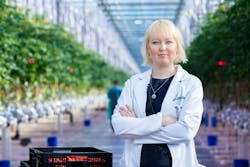Reaffirming the importance of horticultural and agricultural lighting to its future, Signify CEO Eric Rondolat recently projected industry-wide market revenue from the sector of over $2 billion by 2023 and told analysts that the field is currently the leading top-line driver in what the company has identified as its sustainability businesses.
The broad category of “agriculture,” which for Signify includes lighting to nourish the growth and development of food crops, plants and animals, will tally €1.8B (about $2.2B) in 2023, up from €1.5B ($1.8B) in 2020, Rondolat said in a presentation at last month's virtual Capital Markets Day gathering.
While he did not spell out how much of the €1.8B Signify itself hopes to garner, Rondolat made it clear that the horticultural market is a key prong in the company's growth strategy, especially given the food challenges facing the planet.
“We talk about a very, very exciting opportunity because it solves one of the fundamental issues that we’re going to have on the planet, which is food availability and security,” Rondolat said, referring to the ramifications of climate change and population growth. “We cannot feed 10 billion people in 2050 if we produce food in the same way. So this is a market that we see growing by 6%, getting closer to 2 billion at the end of the period (2020‒2023). And we have a unique position with 150-plus light recipes when it comes to crops and also animals. So we’re very well positioned in a business that we have been focusing on for many years.”
LEDs Magazine has reported on some of Signify’s horticultural customers, most recently looking at a new installation at cucumber grower Albuna Farms in Kingsville, Ontario.
To help drive home the point of the company’s experience, for Capital Markets Day Signify rounded up video testimonials from about half a dozen customers that have been using the company’s agricultural products for several years.
“These taste just as good as our summer crops, and they are grown in the dead of winter,” said a tomato grower from Canada’s Blackfalds, Alberta-based Gull Valley Greenhouses.
“Every harvest that comes is predictable, and that’s huge,” said a greens grower with Ecobain Gardens in Saskatoon, Saskatchewan.
“Color is much deeper, darker, richer with LEDs,” claimed a greenhouse lettuce grower with Middlefield, OH-based Great Lake Growers, who even added that “the taste is better with LEDs” (he possibly was comparing LEDs to high-pressure sodium lamps, not to sunlight).
Sustainability defines the ethos these days at Signify, which last September said it had achieved carbon neutrality. The push toward ecofriendliness applies across internal operations and business pursuits. In another example, the company is eliminating plastic packaging from its consumer products.
Rondolat has identified four revenue generators the he refers to as “growth platforms for sustainability,” and which the company expects to tally €5B ($6B) in revenue in 2023, market-wide, including Signify and others.
Using a broad notion of sustainability to include environmental and human wellbeing, the three other sectors are: UV-C, which is known to deactivate the coronavirus that causes COVID-19 and which many lighting companies are pursuing; solar lighting; and 3-D printing of luminaires.
Asked by BofA Merrill Lynch analyst George Featherstone which of the four is the largest at Signify, Rondolat said the agricultural/horticultural sector takes that distinction.
That is not to underplay the importance of UV-C at Signify, which has ramped up production of UV-C products to deactivate the coronavirus on surfaces, objects, and in the air.
Rondolat's figures showed the general market size for UV-C at €1.5B for 2020 – the same as agriculture – growing to €2B ($2.4B) in 2023, slightly more than agriculture's €1.8B. The same slide showed solar at €1.1B ($1.3B) in 2020 growing to €1.7B ($2.1B) in 2023, and 3-D printing at €800M ($966M) growing to €1.2B ($1.4B) in the same period. He did not make projections for Signify's own share of those markets.
*Updated Jan. 18, 2021 10:45 AM - This story has been updated to clarify that Rondolat's stated market sizes and projections are industry-wide figures, not Signify-specific as we said in our original version of Jan. 15. LEDs Magazine apologizes for the error.
*Updated May 26, 2021 1:47 PM for market potential description.
--
This is LEDs Magazine’s latest report from Signify’s Dec. 9 Capital Markets Day 2020. Our previous stories from the event have included an app that eases the pain of bulb bafflement, another about upcoming cutbacks at Signify headquarters, and a look at the ups and downs of the company’s IoT endeavors. Stay tuned for more...
Editor’s note: Signify financials and market numbers are reported in Euros and are converted to US dollar exchange rates at the time of publication.
MARK HALPER is a contributing editor for LEDs Magazine, and an energy, technology, and business journalist ([email protected]m).
For up-to-the-minute LED and SSL updates, why not follow us on Twitter? You’ll find curated content and commentary, as well as information on industry events, webcasts, and surveys on our LinkedIn Company Page and our Facebook page.






